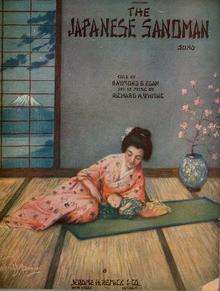The Japanese Sandman
| ""The Japanese Sandman"" | |
|---|---|
 ""The Japanese Sandman"" cover | |
| Song | |
| Composer(s) | Richard A. Whiting |
| Lyricist(s) | Raymond B. Egan |
|
| |
"The Japanese Sandman" is a song from 1920, composed by Richard A. Whiting and with lyrics by Raymond B. Egan.
Content
The song is about a sandman from Japan, who exchanges yesterdays for tomorrows. The number has a very Oriental atmosphere, and is similar to many other songs from the interbellum who sing about a dreamy, exotic setting.
Nora Bayes made a popular recording of the song in 1920. The song was Paul Whiteman's first record and sold over two million copies. It has been subsequently performed by several musical artists like Benny Goodman, Bix Beiderbecke, Artie Shaw, Earl Hines, Paul Young, Django Reinhardt, the Andrews Sisters, Freddy Gardner, Freddy Sunder, and in 2010, a high-fidelity recording of Whiteman's historic arrangement, by Vince Giordano and his Nighthawks Orchestra.
Additionally, the song was recorded by the Nazi German propaganda band Charlie and his Orchestra. For propaganda reasons, the lyrics were changed through references to the Japanese Empire.
In popular culture
The song was often used in American cartoons from the 1930s to the 1940s, such as 1942's The Ducktators, usually to mock Japanese characters, due to the ongoing war between the United States and Imperial Japan.
The 1948 Disney cartoon of Pluto and Figaro has a scene where a sandman wearing an oriental conic straw hat is shown pushing a cart of golden sand that he sprinkles on the eyes of the characters to make them sleepy.
The Japanese boxer Harold Hoshino was nicknamed "The Japanese Sandman" in the 1930s.[1]
Hoagy Carmichael performed the song on ukulele in the 1952 film Belles on Their Toes.
Whiteman's original can also be heard in the 1969 film They Shoot Horses, Don't They? and on The Masked Marauders album from the same year.
Frank Zappa quotes the song on the final track of his album Joe's Garage (1979): "A Little Green Rosetta". Since Zappa was a doo-wop fan, he probably references the cover by the Cellos.
Saint Etienne make a reference to this in their song B92 in their 2002 album Finisterre.
The song appears in the 2009 fantasy film The Imaginarium of Doctor Parnassus.
Instrumental versions appeared in almost every one of the first five episodes of the HBO series Boardwalk Empire. A version with lyrics was featured in the show on October 24, 2010.
References
- ↑ Svinth, Joseph R. (June 2002). "Boxing: Harold Hoshino, the Japanese Sandman". Journal of Combative Sport. Retrieved 2011-03-07.
Sources
- The lyrics (http://lyricsplayground.com/alpha/songs/t/thejapanesesandman.shtml)
- About the song (http://parlorsongs.com/issues/2003-1/thismonth/featureb.php)
- A list with covers of the song (http://honkingduck.com/mc/discography?field_combo_value=&field_selection_value=japanese+sandman)